
I mentioned how well I fared with the lunar eclipse a few posts ago, but as it turned out Jim Kramer (of the Alaskan posts) did a hell of a lot better that evening. Not so well later on, however, as his photo harddrive threw a shoe right after he’d downloaded all of the images and deleted them from his memory card – before, of course, he’d had a chance to back them up. Jim is even more conscientious about backups than I, and I’m pretty anal (and here you thought “Al” was short for something else,) but there are still vulnerable times in any procedure, and Jim got caught. I had a similar situation about ten years ago, right after dumping a bunch of photos to a transfer drive and reformatting the old drive, thus prompting the transfer drive to fail – I had checked the backups, too, before eradicating the originals. My guess is that the sudden weight gain on the drive causes stress, so I would recommend building the drive up first, perhaps by adding a lot [of/more] porn, before loading in the valuable images.
Anyway, Jim took some time rebuilding his system with a RAID array, which is too complicated to explain and besides I don’t know what it is anyway. Then he rescued the photos from the memory card and eventually got them to me yesterday, and if I’d been more on the ball I’d have had this post up then, but so it goes.
At top, a sequence of photos at the end of the eclipse, more or less – this is the moon exiting the umbral shadow, but there is a penumbral shadow that still covers it all, it’s just so thin that the slight dimming of the moon isn’t noticeable to casual viewing – however, a hint of it can be seen by looking at the maria in the far right of the sequence. I believe this is an ‘actual’ progression composite, meaning a true representation of the moon’s motion as it arced across the sky – Jim didn’t tell me (loquacious he’s not,) but the timing strikes me as right. The moon moves roughly its own width in 180 seconds, so this sequence spans about a half-hour.
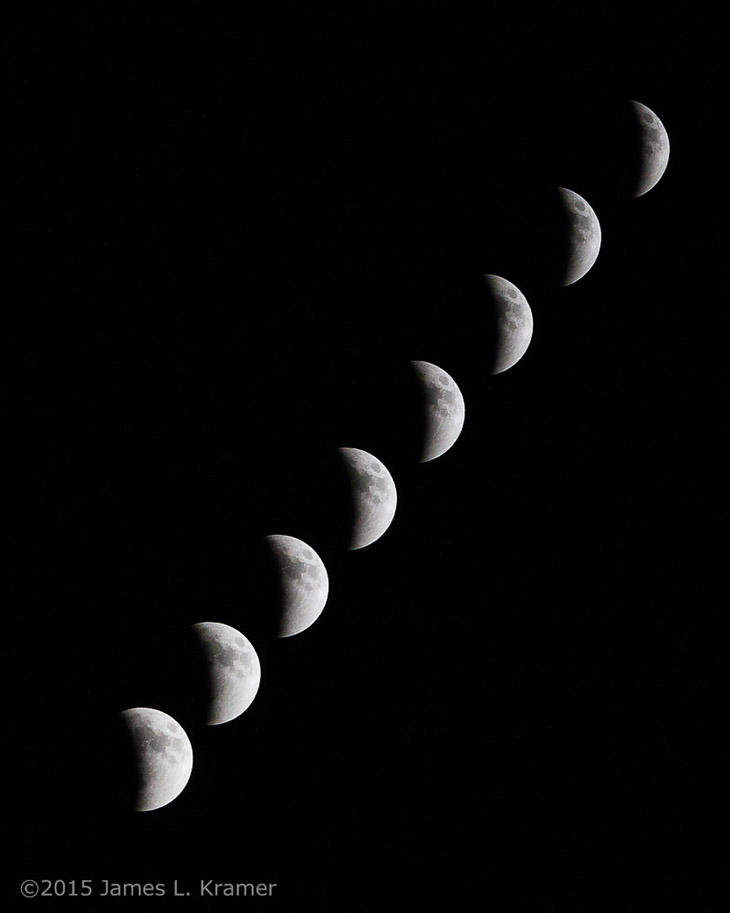
This is a sequence as the eclipse was progressing towards totality, very nicely composed, and exposure was right where it needed to be. Due to orbital mechanics, the moon is moving left-to-right in these images, as it always is in the northern hemisphere, but the shadow of the Earth is overtaking it. Seems odd, but the primary motion of the moon in the sky is due to the Earth’s rotation, and unless you look close it seems to occupy the same position as the stars and move with them. However, it is orbiting on its own, as well as being linked to the Earth’s orbit of the sun, so these two things combined are responsible for the advancement of the shadow across its face. From time to time, you can witness the moon eclipsing a star or a planet, and the moon’s own motion becomes more apparent then. Universe Today is probably the best for letting you know when such a thing is going to occur next.
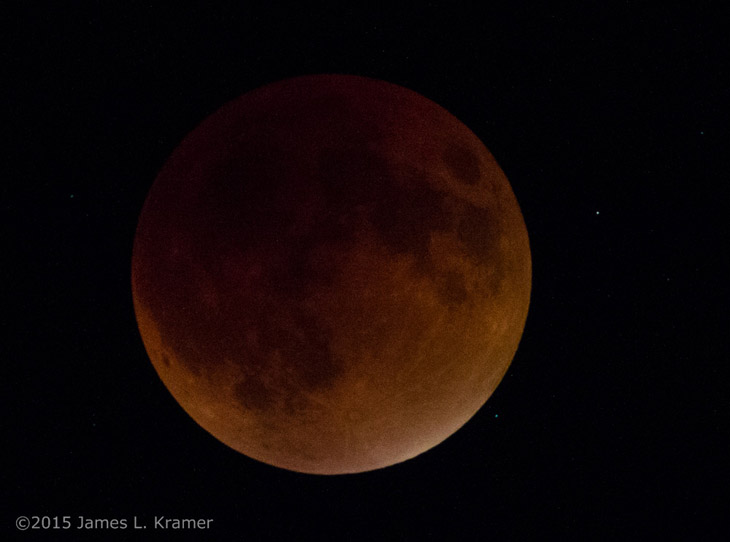
And we arrive at totality, please be sure you have all your belongings. Chances are everyone has already heard why this color is the way it is, but just in case…
The red comes from the sunlight shining, and bending, through the Earth’s atmosphere, the same thing that gives us red sunsets. With a solar eclipse, the moon and the sun are so close in apparent size from our vantage here on Earth that the moon blocks out the sun perfectly, but very briefly (since orbits are elliptical, at times the moon is too far away to completely cover the sun and an annular eclipse occurs instead.) The Earth is much bigger than the moon, however, so the shadow is even bigger, and a lunar eclipse lasts much longer. If it weren’t for the light being bent by Earth’s atmosphere, the moon would be quite dark in this shot. You have noticed that it is actually lopsided, with the darkest portion occurring near Mare Imbrium – this is because the moon almost never passes directly through the shadow, but somewhat off to the side; a little further and all we’d have is a partial eclipse.
For comparison, a lunar eclipse easily darkens the whole moon’s surface. A solar eclipse throws a deep shadow onto only a small portion of the Earth (cool photo – go to that link!)
And yes, those are stars visible in the shot. This image was shot at 1/2 second exposure at f8, ISO 3200, way longer than the exposure needed for a normal unobscured full moon, which would be about 1/4000 second or less for the same settings. Stars usually won’t show up in such a short exposure, and if it was lengthened to capture them, the moon would be ridiculously overexposed. Not to mention that atmospheric humidity would usually throw enough scatter glare close to the moon that they’d be lost anyway.

As the eclipse starts to exit, we get an idea of the relative amounts of light. The bright portion of the moon at lower left is no brighter than a normal full moon, in fact considerably dimmer, but it’s badly overexposed here to be able to see the red portion in nice detail (same settings as the previous image.) And take note of that color range near the terminator, because it’ll come up again on Monday.
Another sequence for comparison.
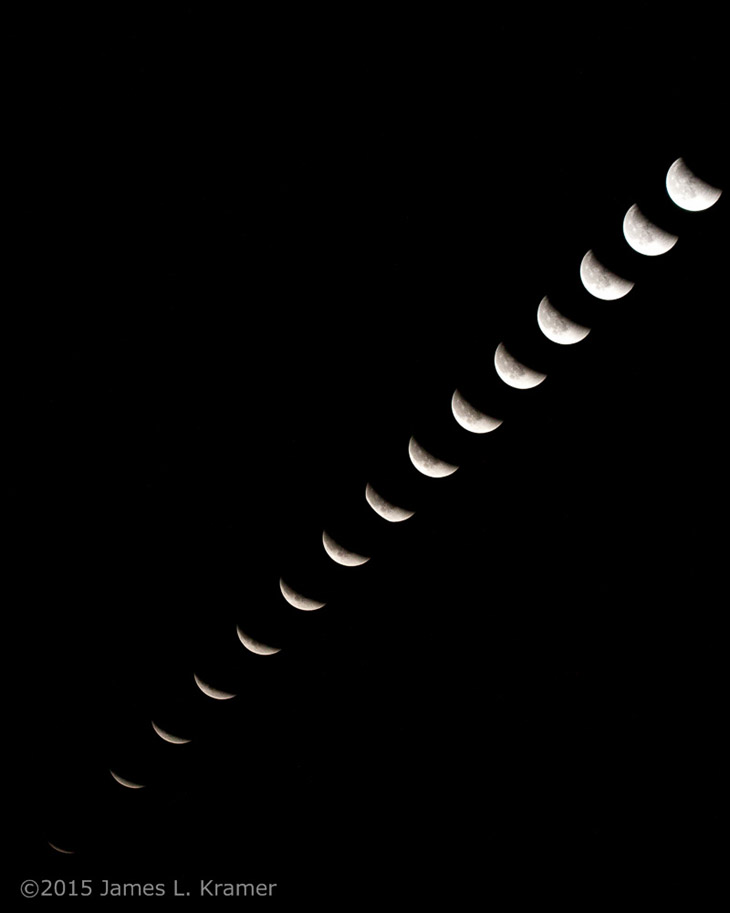
Jim was using two different cameras during the eclipse, and this one was doing wider sequence shots. By doing some simple Photoshop tricks, I can guess that the partial eclipse shot immediately above was taken at roughly the same time as the fourth moon from the bottom in this sequence, so you can compare the results. Again, he didn’t give me details (but might be shamed into confirming them,) so I’m using EXIF info for some of them, which may or may not be accurate for the sequences – we’ll just assume that it is. So each of these exposures was 1/200 second at f11, ISO 800, which means 10 stops difference in exposure, or, 1,024 times more light gathered in the red pics than those immediately above. Little wonder that the red portion of the moon vanished in the sequential shot.
And a last one as the eclipse went bye-bye. This was shot 41 minutes before mine.
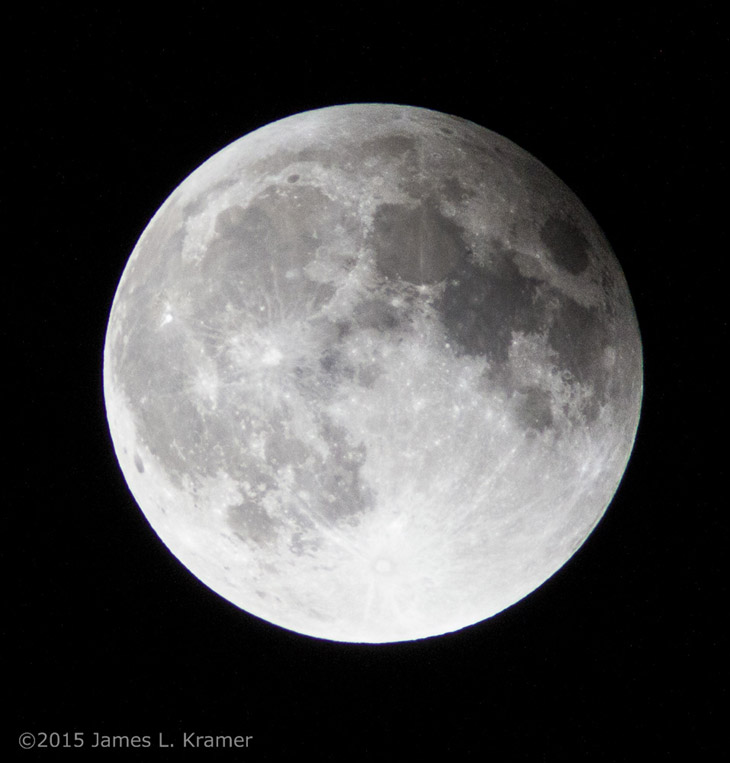
The penumbral shadow is still making its appearance at upper right, while Jim is showing off how much better a lens he has than I do (Jim has been able to afford that kind of jazz.) I have to admit, the detail is pretty slick. So, thanks for the efforts, Jim – nice collection of eclipse pics, which you seem to be having far better luck than I have, for the past several years of eclipses (example one, example two and two-point-five, example three.)
While we are still on the subject of astronomy, the Draconids meteor shower is supposed to be visible tonight and tomorrow night, and these have finally coincided with a largely dark moon to improve viewing conditions. We’ll see what might happen here – I’m far from a decent night sky situation – and if perhaps Jim gets a chance to do a little out in dark-sky Kansas, though it messes badly with his work schedule, I know.





















































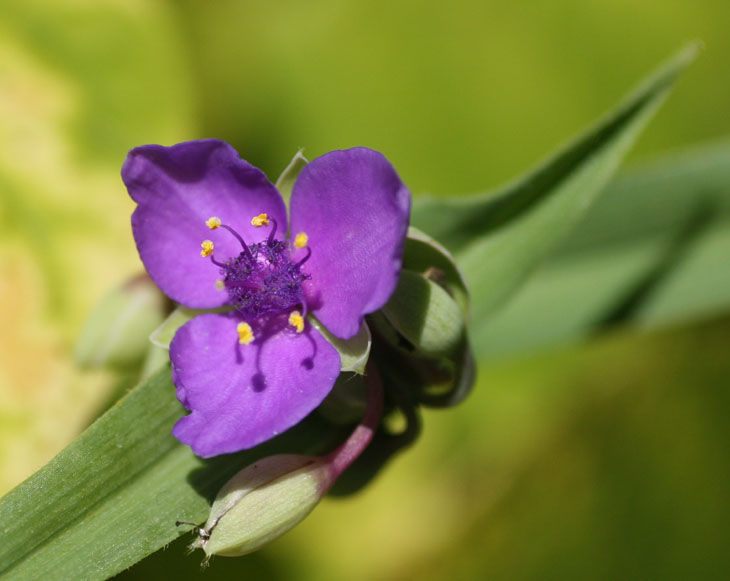
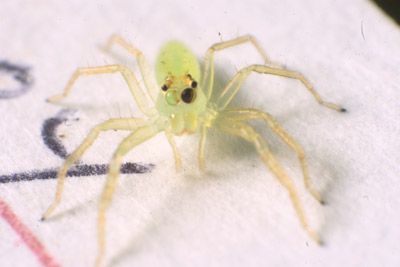 Magnolia greens are the only species I’ve found that allows one to see the internal workings of the eyes without dissection, because their exoskeleton is so translucent. But they’re a small spider, even more so when only a nymph as the last few that I’ve captured, so seeing this takes some significant magnification – the image here was taken on a standard 3×5 index card, and that’s part of my writing that’s visible. I use fine-point pens, by the way…
Magnolia greens are the only species I’ve found that allows one to see the internal workings of the eyes without dissection, because their exoskeleton is so translucent. But they’re a small spider, even more so when only a nymph as the last few that I’ve captured, so seeing this takes some significant magnification – the image here was taken on a standard 3×5 index card, and that’s part of my writing that’s visible. I use fine-point pens, by the way…

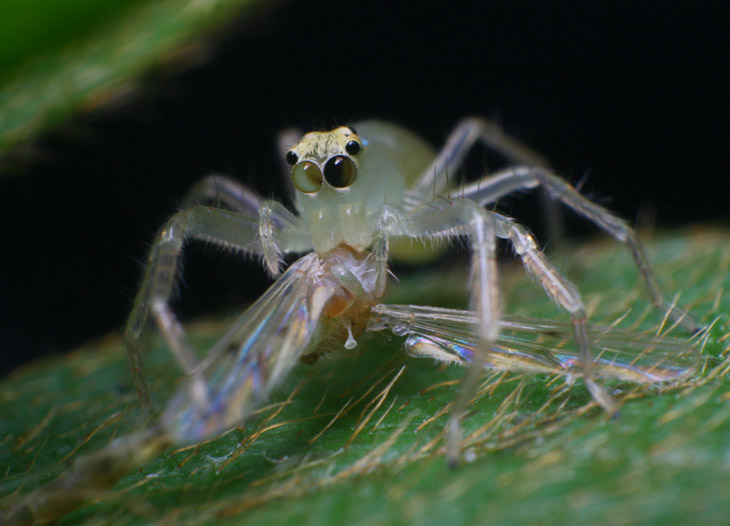



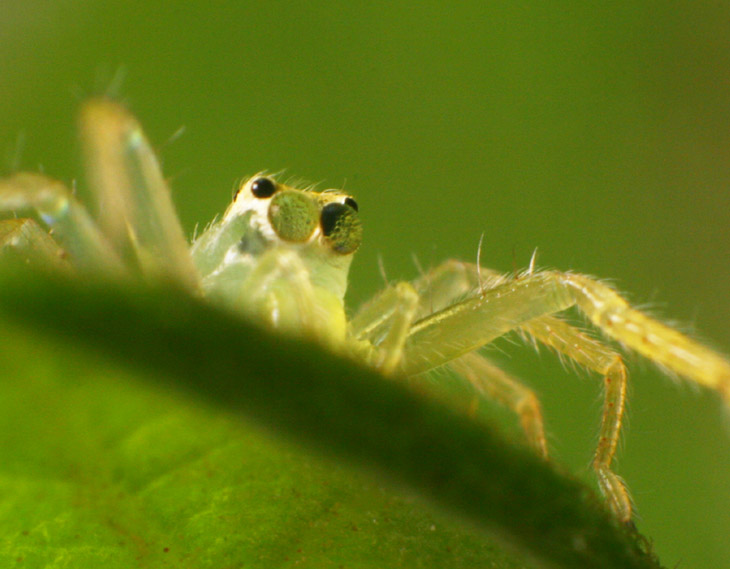
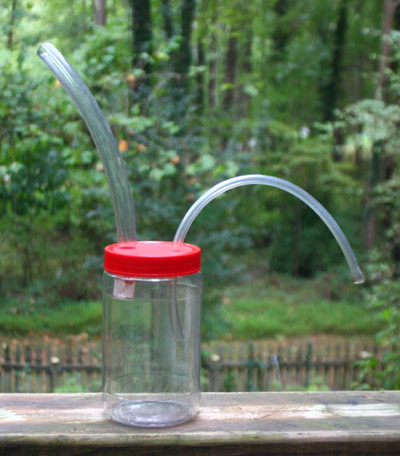
 It works amazingly well, and takes very little inhalation to snag the target. I had used a larger mouth tube to be able to draw an insect all the way up the capture tube easily, but this really doesn’t seem necessary. I would recommend, however, ensuring that it’s easy to distinguish which tube is which, lest you put the wrong one in your mouth and a) mash your target bug against the gauze filter and think that you missed it, and/or b) end up inhaling a previous capture. Also, per the advice of someone else, the jar should be clear but not glass, just for safety’s sake.
It works amazingly well, and takes very little inhalation to snag the target. I had used a larger mouth tube to be able to draw an insect all the way up the capture tube easily, but this really doesn’t seem necessary. I would recommend, however, ensuring that it’s easy to distinguish which tube is which, lest you put the wrong one in your mouth and a) mash your target bug against the gauze filter and think that you missed it, and/or b) end up inhaling a previous capture. Also, per the advice of someone else, the jar should be clear but not glass, just for safety’s sake.

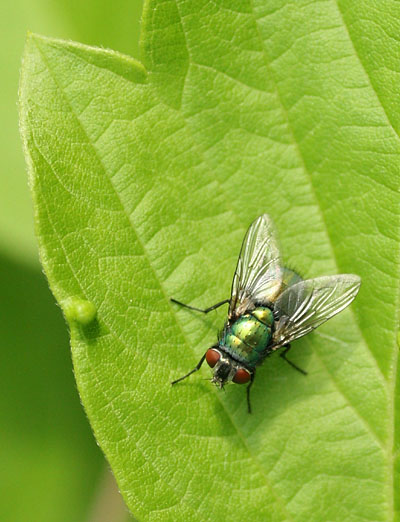 Perhaps not everyone’s idea of cheerful color, and it was a grab shot as I was pursuing other subjects, but it’s vivid – ya gotta give it that.
Perhaps not everyone’s idea of cheerful color, and it was a grab shot as I was pursuing other subjects, but it’s vivid – ya gotta give it that.
 The frame above, by the way, is tightly cropped, and slightly less than full resolution. This one, the same image, shows exactly how big the moon appears in the frame at 453mm focal length, just so you know what kind of magnification it takes for moon photos. For exposure details, 1/100 second at f11, ISO 100 – the typical exposure for full moon shots, provided that it’s not faintly dimmed by haze (basically, at f11, shutter speed should be 1/ISO, what’s often called, “Moony 11”.) A stop or so brighter would have been better, given the glow easily visible around it when observed.
The frame above, by the way, is tightly cropped, and slightly less than full resolution. This one, the same image, shows exactly how big the moon appears in the frame at 453mm focal length, just so you know what kind of magnification it takes for moon photos. For exposure details, 1/100 second at f11, ISO 100 – the typical exposure for full moon shots, provided that it’s not faintly dimmed by haze (basically, at f11, shutter speed should be 1/ISO, what’s often called, “Moony 11”.) A stop or so brighter would have been better, given the glow easily visible around it when observed.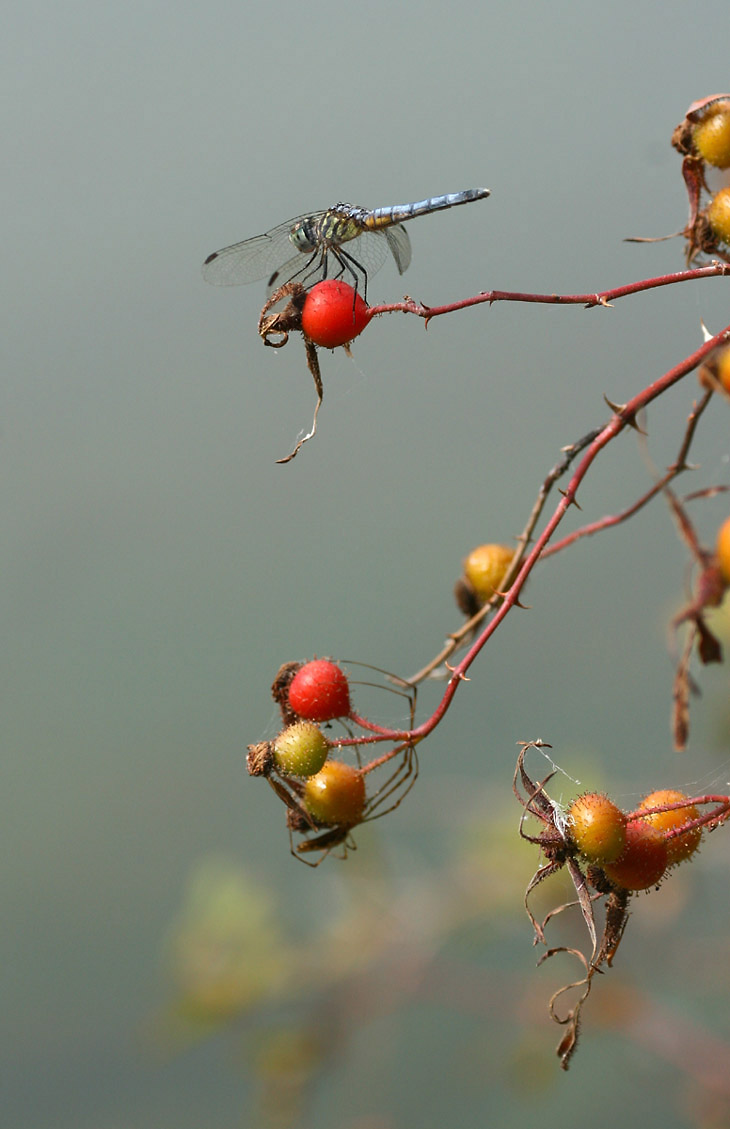
 The mantis from the previous post stayed trapped by the rain for several days, finally leaving its position early this afternoon – naturally while I wasn’t watching. While I was wandering around the backyard, hoping to find where she’d gotten off to, I spotted something else, which I won’t identify and simply let you look at the image to the left to try and find on your own. It gives a pretty good idea of what I saw at first, and the kind of things I pay attention to because they often enough lead to new critters to photograph.
The mantis from the previous post stayed trapped by the rain for several days, finally leaving its position early this afternoon – naturally while I wasn’t watching. While I was wandering around the backyard, hoping to find where she’d gotten off to, I spotted something else, which I won’t identify and simply let you look at the image to the left to try and find on your own. It gives a pretty good idea of what I saw at first, and the kind of things I pay attention to because they often enough lead to new critters to photograph. I am going to identify this as a Cope’s grey treefrog (Hyla chrysoscelis,) with reservations – they cannot be distinguished from the common grey treefrog visually, but so far, the Cope’s is the only species that I’ve confirmed we have around here, solely by
I am going to identify this as a Cope’s grey treefrog (Hyla chrysoscelis,) with reservations – they cannot be distinguished from the common grey treefrog visually, but so far, the Cope’s is the only species that I’ve confirmed we have around here, solely by  Remember, look at your thumb – the distance between the tip and the crease of the joint is how long this little bugger is (unless your hands are way different in size from mine.) But this gives a good view of those little blobby pads at the tips of the toes, which help treefrogs cling to such surfaces, and the brilliant yellow lining of the hind legs which often remain hidden from sight. Don’t ask me the purpose of that coloration, because I could only speculate, and poorly at that.
Remember, look at your thumb – the distance between the tip and the crease of the joint is how long this little bugger is (unless your hands are way different in size from mine.) But this gives a good view of those little blobby pads at the tips of the toes, which help treefrogs cling to such surfaces, and the brilliant yellow lining of the hind legs which often remain hidden from sight. Don’t ask me the purpose of that coloration, because I could only speculate, and poorly at that.
